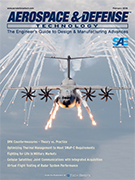Article
AIA predicts flying air taxis, supersonic air travel, and space industry for 2050
2019-03-15
In the “What’s Next for Aerospace and Defense: A Vision for 2050” study, AIA, New York City-based McKinsey & Company, and other industry partners reveal a comprehensive 30-year, Industry 4.0 forecast of air travel and spaceflight based on improvements in automation and digitization, next-generation materials, alternative energy sources and storage, and increased data throughput.












